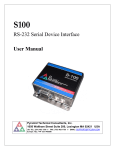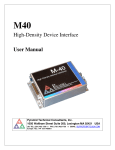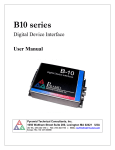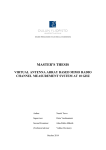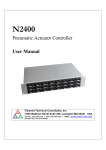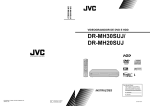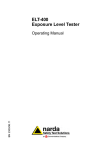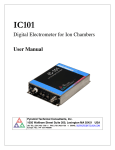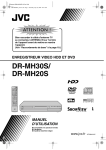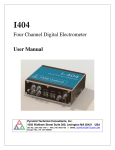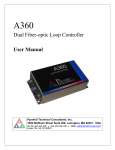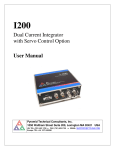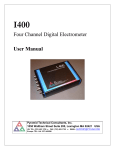Download Manual - Pyramid Technical Consultants
Transcript
H10 MFP-25 / MFP-2.5 Magnetic Probe System User Manual Pyramid Technical Consultants, Inc. 1050 Waltham Street Suite 200, Lexington MA 02421 USA US: TEL: (781) 402 1700 ♦ FAX: (781) 402-1750 ♦ EMAIL: [email protected] Europe: TEL: +44 1273 493590 PSI System Controls and Diagnostics 1 Contents 1 Contents ..............................................................................................................................................................2 2 Table of Figures ..................................................................................................................................................5 3 Safety Information .............................................................................................................................................6 4 Models .................................................................................................................................................................8 5 Scope of Supply ..................................................................................................................................................9 6 Optional Items ..................................................................................................................................................10 7 6.1 Power supplies ..............................................................................................................................................10 6.2 Data cables....................................................................................................................................................10 6.3 Fiber-optic loop ............................................................................................................................................10 6.4 DIN rail mount ..............................................................................................................................................10 Intended Use and Key Features ......................................................................................................................11 7.1 Intended Use..................................................................................................................................................11 7.2 Key Features .................................................................................................................................................11 8 Specification......................................................................................................................................................12 9 Installation ........................................................................................................................................................18 9.1 Mounting .......................................................................................................................................................18 9.2 Grounding and power supply ........................................................................................................................19 9.3 Connection to equipment ...............................................................................................................................20 9.3.1 10 Typical setup ........................................................................................................................................20 Getting Started using the Pyramid Diagnostic Host Programs ....................................................................22 10.1 Preparing the H10 for operation ..............................................................................................................22 10.2 Installing and using the PSI Diagnostic Program ....................................................................................23 H10 User Manual H10_UM_121105 Page 2 of 59 PSI System Controls and Diagnostics 10.2.1 Establishing communication with the H10 ......................................................................................23 10.2.2 Data tab ...........................................................................................................................................25 10.2.3 Setup tab..........................................................................................................................................29 10.2.4 Device tab .......................................................................................................................................31 10.3 Installing and using the PTC G2 Diagnostic Program ............................................................................32 10.3.1 11 12 13 14 Magnetic Measurements ..................................................................................................................................35 11.1 Measures of Magnetic Field Strength.......................................................................................................35 11.2 Field vectors .............................................................................................................................................36 11.3 Rate of Change of Magnetic Flux Density ................................................................................................37 Circuit overview ...............................................................................................................................................38 12.1 MFP-25 Probe ..........................................................................................................................................38 12.2 MFP-2.5 probe .........................................................................................................................................39 12.3 H10 Control Unit ......................................................................................................................................39 Calibration ........................................................................................................................................................41 13.1 Calibration Parameters ............................................................................................................................41 13.2 Temperature Coefficients..........................................................................................................................41 Connectors ........................................................................................................................................................43 14.1 H10 control unit front panel connectors ..................................................................................................43 14.1.1 14.2 15 Establishing communication with the H10 ......................................................................................33 Probe connection .............................................................................................................................43 Rear panel connectors ..............................................................................................................................43 14.2.1 Power input .....................................................................................................................................43 14.2.2 Fiber-optic communications ............................................................................................................44 Controls and Indicators ...................................................................................................................................45 15.1 Front panel controls .................................................................................................................................45 15.2 Rear panel controls ..................................................................................................................................45 15.2.1 15.3 Address switch ................................................................................................................................45 Front panel indicators ..............................................................................................................................45 H10 User Manual H10_UM_121105 Page 3 of 59 PSI System Controls and Diagnostics 15.4 15.4.1 Power ..............................................................................................................................................45 15.4.2 Activity............................................................................................................................................45 15.4.3 Network...........................................................................................................................................45 15.4.4 Device .............................................................................................................................................46 15.5 16 Rear panel indicators ...............................................................................................................................45 Internal settings ........................................................................................................................................46 15.5.1 SW2 settings ...................................................................................................................................46 15.5.2 JPR1 settings ...................................................................................................................................46 Software updates ..............................................................................................................................................47 16.1 FPGA firmware updates ...........................................................................................................................47 16.2 PIC microcontroller firmware updates.....................................................................................................48 17 Versions and Compatibility .............................................................................................................................50 18 Fault-finding .....................................................................................................................................................51 19 Maintenance .....................................................................................................................................................54 20 Returns procedure ...........................................................................................................................................55 21 Support..............................................................................................................................................................56 22 Disposal .............................................................................................................................................................57 23 Declaration of Conformity ..............................................................................................................................58 24 Revision History ...............................................................................................................................................59 H10 User Manual H10_UM_121105 Page 4 of 59 PSI System Controls and Diagnostics 2 Table of Figures Figure 1. H10 control unit end panels. Dimensions mm. ..........................................................................................15 Figure 2. H10 control unit plan and side views. Dimensions mm. .............................................................................16 Figure 3. MFP25 and MFP-2.5 field probe geometry Dimensions mm. ..................................................................17 Figure 4. Probe orientation for a positive field reading (MFP-25 probe; +ve gain coefficient)..................................18 Figure 5. Probe orientation for a positive field reading (MFP-2.5 probe; +ve gain coefficient).................................18 Figure 6. Schematic example H10 setup. ....................................................................................................................20 Figure 7. Schematic example setup for electromagnet field control. ..........................................................................21 Figure 8. Example of a connection to the H10 via an A500 and Ethernet. .................................................................23 Figure 9. PSI Diagnostic Search Utility – adding a target IP address and port ...........................................................24 Figure 10. PSI Diagnostic Search Utility – detection in progress ...............................................................................25 Figure 11. Data tab: MFP-25 probe. ...........................................................................................................................26 Figure 12. Data tab: MFP-2.5 probe. ..........................................................................................................................26 Figure 13. Setup tab – MFP-25 probe ........................................................................................................................29 Figure 14. Setup tab – MFP-2.5 probe .......................................................................................................................30 Figure 15. Device tab, showing firmware update utility controls. ..............................................................................31 Figure 16. PTC Diagnostic G2 discovery dialog after Discover Controllers. .............................................................34 Figure 17. System pane showing an H10 connected via an A500 controller ..............................................................34 Figure 18. H10 data display in PTC Diagnostic G2 ...................................................................................................34 Figure 19. Direction convention for magnetic field lines............................................................................................36 Figure 20. Direction convention for magnetic field lines............................................................................................36 Figure 21. MFP-25 probe block schematic. ................................................................................................................38 Figure 22. MFP-2.5 block schematic. .........................................................................................................................39 Figure 23. H10 control unit block schematic. ............................................................................................................39 Figure 24. Example of MFP-20 temperature compensation. ......................................................................................42 Figure 25. Location of internal switches and jumpers. ...............................................................................................46 Figure 26. Selecting the fhex file to load. ...................................................................................................................47 Figure 27. Restart prompt after FPGA update. ...........................................................................................................48 Figure 28. Selecting the hex file to load. ....................................................................................................................49 Figure 29. Firmware upload in progress .....................................................................................................................49 H10 User Manual H10_UM_121105 Page 5 of 59 PSI System Controls and Diagnostics 3 Safety Information This unit is designed for compliance with harmonized electrical safety standard EN610101:2000. It must be used in accordance with its specifications and operating instructions. Operators of the unit are expected to be qualified personnel who are aware of electrical safety issues. The customer’s Responsible Body, as defined in the standard, must ensure that operators are provided with the appropriate equipment and training. The unit is designed to make measurements in Measurement Category I as defined in the standard. Although the H10 does not generate dangerous voltages, nor is it designed to measure directly such voltages, in your application it may be measuring the field in electromagnets with high voltages present. Appropriate precautions must be taken. The unit must not be operated unless correctly assembled in its case. Only Service Personnel, as defined in EN61010-1, should attempt to work on the disassembled unit, and then only under specific instruction from Pyramid Technical Consultants, Inc. or their authorized distributors. The unit is designed to operate from +24VDC power, with a maximum current requirement of 250mA. A suitably rated power supply module is available as an option. The unit must be grounded by secure connection to a grounded conducting surface. If the unit is mounted on an insulating surface, then one of the four mounting screws must be re-assigned as a grounding connection. Some of the following symbols may be displayed on the unit, and have the indicated meanings. H10 User Manual H10_UM_121105 Page 6 of 59 PSI System Controls and Diagnostics Direct current Earth (ground) terminal Protective conductor terminal Frame or chassis terminal Equipotentiality Supply ON Supply OFF CAUTION – RISK OF ELECTRIC SHOCK CAUTION – RISK OF DANGER – REFER TO MANUAL H10 User Manual H10_UM_121105 Page 7 of 59 PSI System Controls and Diagnostics 4 Models H10-SYS9-2T H10 system comprising H10 control unit, MFP-25 magnetic field probe and 9’ (2.7 m) cable. H10-SYS22-2T H10 system comprising H10 control unit, MFP-25 magnetic field probe and 22’ (6.7 m) cable. MFP-25 Precision magnetic field probe with +/- 2.5 T range. H10-SYS9 H10 system comprising H10 control unit, MFP-2.5 magnetic field probe and 9’ (2.7 m) cable. H10-SYS22 H10 system comprising H10 control unit, MFP-2.5 magnetic field probe and 22’ (6.7 m) cable. MFP-2.5 Magnetic field probe with +/- 0.25 T range and dB/dt coil. H10 User Manual H10_UM_121105 Page 8 of 59 PSI System Controls and Diagnostics 5 Scope of Supply H10 system model as specified in your order. USB memory stick containing: User manual PSI Diagnostic software guide PSI diagnostic software files Power supply Optional items as specified in your order. OEM customers may not receive all the items listed. H10 User Manual H10_UM_121105 Page 9 of 59 PSI System Controls and Diagnostics 6 Optional Items 6.1 Power supplies PSU24-40-1. +24 VDC 1.6 A PSU (100-250 VAC, 50-60 Hz, IEC C14 3-pin plug receptacle) with output lead terminated in 2.1mm threaded jack. 6.2 Data cables CAB-ST-P-x-ST Fiber-optic cable, 1 mm plastic, ST terminated, x m long. CAB-ST-HCS-x-ST Fiber-optic cable, 200 um silica, ST terminated, x m long. 6.3 Fiber-optic loop A200 USB to fiber-optic adaptor. A360 fiber-optic loop controller / Ethernet adaptor. A500 intelligent real-time controller with Ethernet interface. A560 intelligent real-time controller with Ethernet interface. 6.4 DIN rail mount MTG-DIN35-11462. Mounting adaptor for 35mm standard DIN rail. H10 control unit can be mounted along or across the rail. H10 User Manual H10_UM_121105 Page 10 of 59 PSI System Controls and Diagnostics 7 Intended Use and Key Features 7.1 Intended Use The H10 system is intended for magnetic field measurement, particularly in electromagnets. The field can be monitored at rates sufficient for real-time monitoring and for field control, and the probe design eliminates magnetic materials or conducting surfaces that would distort the measurement of AC fields. The MFP-2.5 probe is particularly suited to measure the magnetic fields typical of fast scanning electron beamlines such as medical therapy systems, industrial radiography, materials modification, and sterilization. The MFP-25 probe is particularly suited to measure the magnetic fields typical of ion beamlines which use conventional (nonsuperconducting) electromagnets, and has the range and precision to perform well in many general field measurement applications. The H10 has design features which make it tolerant of electrically noisy environments, but the place of use is otherwise assumed to be clean and sheltered, for example a laboratory or light industrial environment. The unit is typically integrated into a larger system, using fiber optic communication links. It can be operated independently, if combined with a suitable fiber optic loop controller and host computer. Users are assumed to be experienced in the general use of precision electronic circuits for sensitive measurements, and to be aware of the dangers that can arise in high-voltage circuits. 7.2 Key Features Dual-range magnetic field measurement. Probes designed to measure correctly in AC fields. High performance HE244 Hall effect device (MFP-25). Probe temperature sensor and compensation (MFP-25). Automatic temperature and zero compensation (MFP-2.5). Integrated pick up loop for direct dB/dt measurement (MFP-2.5). Field inputs can be read at over 10 kHz, if communications rates to the host system allow. Can be operated in a fiber-optic serial communication loop with up to fifteen other devices. USB interfacing to a host computer available via the A200 loop controller. 100BaseT Ethernet interfacing to a host computer available through the A360, A500 and A560 loop controllers. H10 User Manual H10_UM_121105 Page 11 of 59 PSI System Controls and Diagnostics 8 Specification MFP-25 probe Analog signals Magnetic flux density Probe temperature / Hall device current source voltage Field ranges +/- 2.5 Tesla (+/-25 kGauss) +/- 0.625 Tesla (+/-6.25 kGauss) Selected by software control. Sensitive area < 1 mm square (1 mm2) Field direction Field entering the marked top surface of the probe gives a positive field reading (see figure 4). Absolute accuracy Better than 0.01% of full scale of selected range at 25 C. Temperature coefficient of gain (negative) < 200 ppm C-1 (temperature compensation disabled) Temperature coefficient of offset < 0.05 Gauss C-1 (temperature compensation disabled) Noise < 0.005 % rms relative to full scale with lowest downsampling setting. < 50 ppm C-1 (temperature compensation enabled) < 0.01 Gauss C-1 (temperature compensation enabled) < 0.0005% rms relative to full scale at 100 msec averaging. Step response Better than 100 usec to within 0.1% of full scale deviation from target setting for any instantaneous field step. Observed step depends on selected downsampling. Resolution Smallest increment of field 0.61 Gauss (2 Tesla range), 0.15 Gauss (0.5 Tesla range) before averaging. Linearity 0.05 % maximum deviation relative to full scale of any point from linear fit to all points over full span. Connector Lemo 10-way EXG.1B.310 Probe body materials Glass-reinforced polycarbonate, FR4 fiberglass epoxy. Weight 60 g (2.1 oz) Dimensions (see figure 3) MFP-2.5 probe Analog signals H10 User Manual Magnetic flux density H10_UM_121105 Page 12 of 59 PSI System Controls and Diagnostics Pickup loop signal (field rate of change) Hall sensor Field ranges +/- 0.25 Tesla (+/-2.5 kGauss) +/- 0.025 Tesla (+/-250 Gauss) Selected by software control. Sensitive area 0.5 mm square (0.25 mm2) Field direction Field entering the marked top surface of the probe gives a positive field reading (see figure 4). Absolute accuracy Better than 0.8% of full scale of selected range at 25 C. Temperature coefficient of gain < 100 ppm C-1 Temperature coefficient of offset < 0.2 Gauss C-1 Step response Better than 250 usec to within 0.1% of full scale deviation from target setting for any instantaneous field step. Observed step depends on selected downsampling. Resolution Smallest increment of field 0.08 Gauss (0.25 Tesla range), 0.008 Gauss (0.025 Tesla range) before averaging. Linearity 0.05 % maximum deviation relative to full scale of any point from linear fit to all points over full span. Pickup loop sensor Ranges +/- 200 T s-1 +/- 20 T s-1 Selected by software control. Sensitive area 150 mm2, five turns Absolute accuracy < 0.2% of full scale Linearity 0.5 % maximum deviation relative to full scale of any point from linear fit to all points over full span. Temperature coefficient of gain < 0.05% C-1 Bandwidth 10 Hz to 50 kHz (- 3dB) Connector Lemo 10-way EXG.1B.310 Probe body materials Glass-reinforced polycarbonate, FR4 fiberglass epoxy. Weight 60 g (2.1 oz) H10 User Manual H10_UM_121105 Page 13 of 59 PSI System Controls and Diagnostics Dimensions (see figure 3) H10 control unit Digitization 16 bit successive approximation over full range Sample rate 50 kSa s-1 Downsampling Averaging from 4 to 50,000 conversions per reading Calibration Gain and offset values for each analog signal and each range stored in EEPROM. Communications to loop controller Fiber optic (10 Mbit/sec) Data rate through to host computer 1 kHz typical, up to 10 kHz in lightly-loaded networks and fast host systems Probe connector Lemo 10-way EXG.1B.310 Controls 16 position rotary switch for loop address selection Displays Four LEDs (power, activity, network, device). Power input +24 VDC (+12 V, -4 V), 100 mA typical, 200 mA maximum. Case Stainless steel. Case protection rating The case is designed to rating IP43 (protected against solid objects greater than 1mm in size, protected against spraying water). Weight 0.24 kg (0.55 lb). Operating environment 0 to 35 C (15 to 25 C recommended to reduce drift and offset) < 80% humidity, non-condensing vibration < 0.2 g all axes (1 to 1000Hz) Shipping and storage environment -10 to 50C < 80% humidity, non-condensing vibration < 2 g all axes, 1 to 1000 Hz Dimensions (see figures 1 and 2). H10 User Manual H10_UM_121105 Page 14 of 59 PSI System Controls and Diagnostics Rcv Address CAL STATUS Xmit POWER RUN Power +24VDC POWER IN FIBER-OPTIC TX FIBER-OPTIC RX STATUS LEDs ADDRESS SELECTOR HALL PROBE INPUT 77.5 79.9 Figure 1. H10 control unit end panels. Dimensions mm. H10 User Manual H10_UM_121105 Page 15 of 59 PSI System Controls and Diagnostics 4X Ø3.66 MOUNTING HOLE 3.8 114.0 62.0 103.7 28.1 0.60 121.6 Figure 2. H10 control unit plan and side views. Dimensions mm. H10 User Manual H10_UM_121105 Page 16 of 59 PSI System Controls and Diagnostics Figure 3. MFP25 and MFP-2.5 field probe geometry Dimensions mm. H10 User Manual H10_UM_121105 Page 17 of 59 PSI System Controls and Diagnostics 9 Installation 9.1 Mounting The MFP probe should be mounted so that the sensitive spot is located in the field you want to measure. It will measure the field component normal to the flat surface of the probe. The polarity depends on the probe type. The MFP-25 probe will show a positive value for a field vector entering on the centre of the bullseye pattern. N S Figure 4. Probe orientation for a positive field reading (MFP-25 probe; +ve gain coefficient). The MFP-2.5 probe will show a negative value for a field vector entering on the centre of the bullseye pattern. S N Figure 5. Probe orientation for a positive field reading (MFP-2.5 probe; +ve gain coefficient). H10 User Manual H10_UM_121105 Page 18 of 59 PSI System Controls and Diagnostics If you have both types of probe in your system, and want them to have the same response to field direction, then you can simply invert the calibration gain factor of one type to achieve this. The mounting should prevent any tendency for movement or vibration, especially if the probe is measuring a fringe field where there is field curvature. If the field has significant AC components, the mounting should be non-conducting to avoid measurement errors due to eddy currents. The H10 control unit must be mounted within cable reach of the MFP probe. Two standard cable lengths are available, 9 foot and 22 foot, with the shorter cable preferred for best noise performance. The control unit may be mounted in any orientation, or may be simply placed on a level surface. Four M3 clear holes are provided in the base flange on a 62 mm by 114 mm rectangular pattern (see figure 2). A DIN rail adaptor is available for the H10 control unit. The mounting position should allow sufficient access to connectors and cable bend radii. Leave 60mm clearance at either end for mating connectors and cable radii. H10 system includes temperature compensation, but you will get maximum precision if the control unit, and particularly the probe, are in a temperature-controlled environment. No forcedair cooling is required, but free convection should be allowed around the cases. 9.2 Grounding and power supply A secure connection should be made via the H10 control unit mounting flange to local ground potential. If the unit is mounted on an insulating surface, then one of the four mounting screws must be re-assigned as a grounding connection. +24 VDC power should be provided from a suitably-rated power supply with the following minimum performance. If you purchased your H10 as an end-user, a compatible power supply will have been provided. Output voltage +24 +/- 0.5 VDC Output current 300 mA minimum, 2000 mA maximum Ripple and noise < 100 mV pk-pk, 1 Hz to 1 MHz Line regulation < 240 mV The H10 is tolerant of line voltage in the range 18 VDC to 36 VDC, although we recommend using a 24 V supply with reasonable output regulation, as indicated. The H10 includes an internal automatically re-setting PTC fuse rated at 1.1 A. However the external supply should in no circumstances be rated higher than the H10 connector limit of 5 A, and a maximum of 2.0 A is recommended. H10 User Manual H10_UM_121105 Page 19 of 59 PSI System Controls and Diagnostics 9.3 Connection to equipment 9.3.1 Typical setup Figure 6 shows a typical installation to monitor a magnetic field, in schematic form. An MFP probe is measuring a field component normal to the flat face of the probe. It is connected to the H10 control unit via the cable included with the H10 system. Note that this cable can be connected either way round. The H10 is on a fiber-optic communication loop, under control of one of the Pyramid Technical Consultants, Inc. loop controllers (A200, A360, A500, A560). Software on the host computer displays the field readings and controls provided by the H10. A5#0 Other devices H10 MFP-xx Fiber-optic comms +24V in Figure 6. Schematic example H10 setup. Once the H10 is included in such a system, it becomes practicable to implement closed-loop field control, as illustrated in figure 7. The example shows both H10 and M10 on the same fiber optic loop, but this is not essential. The M10 would typically be mounted on or in the power supply, whereas the H10 must be close to the magnet; magnet and power supply may be some distance apart. Software in the fiber optic loop controller, or in the host computer system, can control an electromagnet power supply to reach a target as measured by the H10, using an M10 general purpose I/O device to interface the power supply. H10 User Manual H10_UM_121105 Page 20 of 59 PSI System Controls and Diagnostics A5#0 Magnet PSU M10 +24V in H10 MFP-xx +24V in Figure 7. Schematic example setup for electromagnet field control. H10 User Manual H10_UM_121105 Page 21 of 59 PSI System Controls and Diagnostics 10 Getting Started using the Pyramid Diagnostic Host Programs Usually you will use a custom application to communicate with the H10, either one you write yourself using the software interfaces available from Pyramid Technical Consultants, Inc., or one that is supplied by Pyramid. However you can get started immediately using one of the PSI Diagnostic host programs. These are available for free download from www.ptcusa.com, and are provided with the H10 for end-user customers. There are two generations of the Diagnostic software, and the H10 is compatible with both. PSI Diagnostic. This software supports all Pyramid products, apart from G2 devices. It allows you to connect the H10 via an A500 controller. Ethernet communications use UDP with an added reliability layer. PTC Diagnostic G2. This software supports all G2 devices such as the A560, I128 and C400, plus a growing selection of other Pyramid devices, including the H10. It allows you to connect the H10 via an A500 or A560 controller. Ethernet communications use TCP/IP and UDP. Both Diagnostics are standalone Windows programs which allow you to set outputs and read, graph and log data from the H10. Their user interfaces are similar. For some applications one of the Diagnostic programs may be adequate for all of your data acquisition needs. In any event it is useful to understand what you can do with the Diagnostic programs, because they expose all of the functions of the devices they connect to. Application programmers will find this useful to help decide which functions to implement in their own host software. It is useful to understand what you can do with the Diagnostic programs, because they expose all of the functions of the H10. Application programmers will find it useful to help decide which functions to implement in their host software. 10.1 Preparing the H10 for operation Inspect the unit carefully to ensure there is no evidence of shipping damage. If there appears to be damage, or you are in doubt, contact your supplier before proceeding. Connect the probe to the H10 control unit using the cable supplied. Connect 24 V DC power. The LEDs will go through a startup sequence when the power is applied. All four LEDs light, then the power LED stays lit while the other three indicators light in sequence. When the H10 has started correctly, and prior to connecting to a controller, the power LED will remain lit and the device LED will flash, showing that the device has automatically started measuring data. It is simplest to start with to connect the H10 directly to a loop controller as the only device on the loop. The address switch can be set to anything between 1 and 15. Figure 7 shows a connection to an A500. The A500 controller has a static IP address defined by a software setting of the first three bytes, and rear panel switches for the last byte. It is simplest if you set your PC to an IP4 static address in the same subnet range. For example if the A500 has address 192.168.100.213, then the PC could be 192.168.100.113, with subnet mask 255.255.255.0. H10 User Manual H10_UM_121105 Page 22 of 59 PSI System Controls and Diagnostics Ethernet A500 Fiber-optic comms H10 +24V in Figure 8. Example of a connection to the H10 via an A500 and Ethernet. 10.2 Installing and using the PSI Diagnostic Program If you are an end-user, your H10 was shipped with a USB memory stick with the installation files you need. We recommend that you copy the files into a directory on your host PC. Check the Pyramid Technical Consultants, Inc. web site at www.ptcusa.com for the latest version. The program runs under the Microsoft Windows operating system with the 4.0 .NET framework. This has to be installed before the PSI Diagnostic. Most new PCs have .NET already installed. It can be downloaded from the Microsoft web site at no charge. The Pyramid installer will prompt you if you need to update the version on your computer. Install the PSI Diagnostic by running the PTCDiagnosticSetup.msi installer, and following the screen prompts. Once the program has installed, you can run it at once. It will allow you to connect to the H10, and, depending upon your setup, multiple additional devices at the same time. The Diagnostic uses the concepts of ports and loops to organize the connected devices. A port is a communications channel from your PC, such as a COM port, a USB port or Ethernet port. Each port can be a channel to one or more loops, and each loop may contain up to 15 devices. 10.2.1 Establishing communication with the H10 Start the PSI Diagnostic. It will search the available ports on your computer and present a search list in an autodetect utility window. Figure 7 shows a case where the program found two serial ports and a network adaptor. One IP address was defined in a previous session with the program. We’ll work through an example where the connection to the H10 is via an A500 at IP address H10 User Manual H10_UM_121105 Page 23 of 59 PSI System Controls and Diagnostics 192.168.100.213. We can add this specific address to the network search to avoid the need to broadcast to the whole LAN by typing the address followed by a colon and the standard port number 100, as shown in the figure, and clicking “Add IP”. Figure 9. PSI Diagnostic Search Utility – adding a target IP address and port Check that the target port is checked for inclusion in the search and click the “Start” button. The autodetection process will start (figure 10). H10 User Manual H10_UM_121105 Page 24 of 59 PSI System Controls and Diagnostics Figure 10. PSI Diagnostic Search Utility – detection in progress After a few seconds the program should find the H10 (plus any other devices you may have connected). The System pane will show a tree of all the discovered devices. On the H10 control unit itself you should see the network LED illuminate regularly to show that loop messages are being processed. 10.2.2 Data tab Clicking on the H10 entry in the explorer list will open the H10 window (figures 9 and 10) after a few seconds. The screen layout details depend which probe type you are using. The device will be acquiring data using default settings and you should see background noise values for the field reading. The Device LED on the H10 will flash to show acquisition is in progress (it will turn off if you abort the acquisition). You can display the signals either as a scrolling value against time graph (like a chart recorder) or as an analog bargraph. Toggle to one of the fixed Y scales if you want to inhibit autoscaling of the graph. H10 User Manual H10_UM_121105 Page 25 of 59 PSI System Controls and Diagnostics Figure 11. Data tab: MFP-25 probe. Figure 12. Data tab: MFP-2.5 probe. H10 User Manual H10_UM_121105 Page 26 of 59 PSI System Controls and Diagnostics Select one of the fixed Y scales if you want to inhibit autoscaling of the graph. You can display the analog signals either as a scrolling value against time graph (like a chart recorder) or as an analog bargraph. The scope display mode looks the same as the strip chart, but the data is displayed without scrolling for each 256 readings. Try out the various screen controls and readouts to see their effect. Initiate / Abort These buttons start and stop data acquisition. Screen LEDs indicate whether the H10 is measuring, triggered or streaming data to the controller in fast mode. On the H10 control unit, you will see the Device LED flashing when readings are being taken, and off when data taking is aborted. I/O The analog readings displayed depend on the probe type. For the MFP-25, analog channel one is used for the probe temperature sensor and the Hall sensor compliance voltage (the voltage required to establish the constant current). One or the other can be displayed. Analog channel two is used for the field reading +/-25 kGauss (+/-2.5 T). For the MFP-2.5, analog channel one is used for the dB/dt pickup loop signal, and you can select a low gain (x1, +/-20 T s-1) or high gain (x10, +/-200 T s-1) setting. Analog channel two is used for the field reading and you can select from a +/-2.5 kGauss The checked channels are displayed on the strip chart and scope mode displays. For example you may wish to uncheck channel 1 so that you can concentrate on the plotting of field. Note that this does not stop the data being collected – both channels are always logged. Triggers This counter shows the number of readings made by the H10 since the last initiate. The number of readings you can log on the host computer may be less, depending on the number of readings you request, the averaging period and the available data rate up to the loop controller and the host computer. Board temperature This is a readback of the internal temperature of the H10 control unit in degrees centigrade. Buffer The PSI Diagnostic collects data coming from the H10 into a buffer, with a rate that is the lesser of the actual acquisition rate or the X axis rate setting. The buffer contents can be cleared with the Clr button ( ), or can be written to a .csv file with the save button ( ). The buffer number shows how much data is currently in the buffer. The maximum allowed is 65535 bytes, after which the buffer wraps around to overwrite the earliest values. You can toggle data plotting and accumulation into the buffer with the Run Plot control ( / ). When the accumulation is halted, then the slider is enabled, which allows you to scroll back through the data when in strip chart mode. H10 User Manual H10_UM_121105 Page 27 of 59 PSI System Controls and Diagnostics Y: This drop-down controls the vertical scaling of the data plot. You can select automatic scaling or various fixed proportions of the nominal 10 V full scale. Note that if you have both analog channels checked, you will be plotting two different physical units at the same time, which can lead to lack of vertical resolution. Uncheck the reading you are less interested in and set a vertical scale for the remaining reading. Display only positive values This control is enabled for fixed vertical scaling. It toggles the graphic from a display that is symmetric around 0 to one that shows only 10% of the vertical scale in the negative direction. X: This drop down controls how fast new points are added to the data plot and the data log. For example, if your acquisition settings generate a value every 100 msec but you have 1 second selected on this control, then every tenth reading will be stored. Filtering The PSI Diagnostic can apply a filter to the plotted data to allow you to pick small signals out of noise. This filter is independent of, and additional to, the block averaging filtering implemented by the H10 itself. The PSI Diagnostic filter is a simple IIR type, Yplot_N = Ynew/A + (1-1/A)Yplot_N-1, where Ynew is the latest reading, Yplot_N is the current value to be plotted, Yplot_N-1 is the prior plotted value and A is the averaging value from the pull-down menu. You clear and restart the filter at any time by pressing the reset button . The filtering affects the graphed data and digital displays. If you choose to save the buffered data, you will have the opportunity to save the raw values or the filtered values. DC/AC The DC/AC toggle removes the DC component from the strip chart or scope mode graphic data, but does not affect the digital display or the logged data. / Zero correction / When you press zero, the current values are captured and subtracted from all subsequent readings as displayed on all the graphic and digital displays, until you press the clear zeroes button . If you choose to save the buffered data, you will have the opportunity to save the raw values or the zero offset corrected values. Differential display When this control is pressed, the graphic changes to display the difference between successive readings. The buffered data is not affected. Graphic mode H10 User Manual You can plot the data as a rolling strip chart or a bar chart (histogram). The scope mode is a variant of the strip chart. Instead of a rolling chart, the graphic is refreshed as a whole for each 256 samples. In histogram mode you can place a cursor on a particular channel to read out its value. H10_UM_121105 Page 28 of 59 PSI System Controls and Diagnostics Clear buffered data. Values are cleared from the PSI Diagnostic data buffer, but any acquisition in progress continues and timestamps are not reset. Save data buffer contents to csv file. When you click this button you will see a drop down selection which allows you to save either the raw data, or the values with the PSI Diagnostic zero offset and averaging 10.2.3 Setup tab Click on the “Setup” tab. Here you can alter scaling, polarities, averaging and calibration values. The details of the screen depend on the probe type. Figure 13. Setup tab – MFP-25 probe H10 User Manual H10_UM_121105 Page 29 of 59 PSI System Controls and Diagnostics Figure 14. Setup tab – MFP-2.5 probe Trigger Points The number of readings that the H10 will take after being initiated. If you click the INF button, it will take readings indefinitely. Averaging period The two analog inputs are converted in the H10 control unit at 50 kSa/s. A digital filter then averages the samples over the selected period to give the final values that are transmitted back to the host system. The H10 starts up with the integration period set to the inverse of the mains frequency, as set on the Device tab. Calibrate These factors and offsets are determined during factory calibration of the probe and H10 unit, and should not need further alteration. The green LED by the MFP-25 probe serial number indicates that the original factory calibration is valid, provided you have that probe connected. See section 13 for more details. Pressing the Reset button returns all gains to defaults and offsets to zero. Pressing the Zero button starts an automated zero offset compensation in which the current zero values are measured for all relevant signals and ranges, and the results are used as the offset values. The probe should be shielded from magnetic fields before using this function. H10 User Manual H10_UM_121105 Page 30 of 59 PSI System Controls and Diagnostics 10.2.4 Device tab Click on the “Device” tab. You can check the communication link status, read the H10 manufacturing serial number and verify the versions of the hardware and firmware. The page is the same for both probe types. On the right is the firmware update utility. You can use this to download firmware updates (.hex files) downloaded from the Pyramid Technical Consultants, Inc. web site. Figure 15. Device tab, showing firmware update utility controls. Communication The counters show details of the communications between the H10 and its host loop controller. You can click the Reset Counters button to reset the fields to zero. System controls Pressing :SAFEstate sets a mode in which the H10 goes to a defined safe state if it does not communicate with its host controller in the timeout period in seconds set by the :COMM:TIMEout parameter. Since the H10 is an input device only, this feature has little effect and can be ignored. If you want to disable this feature, set the timeout to 0. Pressing :AUTOrecover sets a state in which the H10 will attempt to restart automatically if it detects data corruption. The COMM:Term and COMM:Checksum controls are not used on the H10. You can ignore them when using the PSI Diagnostic The system controls are software password protected, so you will see a red warning message at the bottom of the window when you use them. The H10 User Manual H10_UM_121105 Page 31 of 59 PSI System Controls and Diagnostics PSI Diagnostic automatically sends the password. Frequency This parameter sets the averaging period that will be used by default on power up. You should set it to the local line frequency. SerialNumber This is the manufacturing serial number of the H10 control unit, and should be left unchanged. Comm:Timeout The time period in seconds without communications before the H10 goes to the safe state. Set to zero if you don’t want this feature. Select .hex file This button starts the H10 PIC firmware update process. It opens a file selection dialog. When you select a hex file it will start uploading to the H10 immediately. Upon completion the H10 will restart automatically, and you will see the new Device Version number displayed. See section ## for more details. Select .fhex file This button starts the H10 FPGA firmware update process. It opens a file selection dialog. When you select a fhex file it will start uploading to the H10 immediately. Upon completion you will need to power cycle the H10, which will cause the new code to be loaded. You will see the new FPGA Version number displayed. See section ## for more details. Reset This button causes a full warm reset of the H10. 10.3 Installing and using the PTC G2 Diagnostic Program The PTC Diagnostic G2 host software provides the same user functions as the PSI Diagnostic, and has a similar look and feel, but it is built on a different software foundation. Unlike the PSI Diagnostic, the PTC Diagnostic G2 uses the same DLL function libraries that Pyramid uses to build user applications. These libraries can be provided to customers who want to build their own applications. The G2 Diagnostic can often provide faster average data rates to the host by its use of block data transfers. If you need a Diagnostic to operate the H10 in conjunction with G2 devices such as the A560, I128, and C400, then you must use the PTC Diagnostic G2. PTC Diagnostic G2 can coexist with the PSI Diagnostic on the same computer. Both programs can in fact communicate with an A500 or A560 the H10 at the same time (the PSI Diagnostic must be launched first), although this is not generally recommended, as the results could be very confusing. Since the two programs are similar, we shall concentrate on the differences. Download the PTC Diagnostic G2 installer (.msi file) or find the copy on the USB memory stick if you purchased the H10 as an end-user. We recommend that you copy the installer file into a directory on your host PC. Check the Pyramid Technical Consultants, Inc. web site at www.ptcusa.com for the latest version. The program runs under the Microsoft Windows operating system with the 4.0 .NET framework. This has to be installed before the PSI Diagnostic. Most new PCs have .NET already installed, H10 User Manual H10_UM_121105 Page 32 of 59 PSI System Controls and Diagnostics or it can be downloaded from the Microsoft web site at no charge. The Pyramid installer will prompt you if you need to update the version on your computer. 10.3.1 Establishing communication with the H10 Start the PTC Diagnostic G2. The program expects all connections to devices like the H10 be via Ethernet ports, whether through dedicated loop controllers like the A500, A560 and A360, or via other Ethernet-enabled devices that support slave devices, such as the I128. Unlike the PSI Diagnostic, you do not need to specify the IP address. When you launch the program, it will open the Discover Devices dialog. Pressing the Discover Controllers button will give you a list of available controllers. The search will include all devices visible on your accessible subnet, including any on the far end of a VPN link. In the following example the search has found various controllers. If your target controller is not discovered, then you can force it to be probed by adding its IP address specifically. Unlike the PSI Diagnostic, you do not need to include a port number. The A60 Recovery entry is a diagnostic utility used for some G2 devices, which you can ignore. Note that the “Not Connected” message returned by A500 controllers can be ignored. This field will be used in a future firmware release to show the IP address of the host device (your computer). H10 User Manual H10_UM_121105 Page 33 of 59 PSI System Controls and Diagnostics Figure 16. PTC Diagnostic G2 discovery dialog after Discover Controllers. Highlight the target device, which is an A500 at 192.168.100.213 in this example, to enable the Connect & Discover Subdevices button. Clicking this should result in the controller appearing in the System area on the left, with its connected sub-devices shown. Figure 17. System pane showing an H10 connected via an A500 controller Clicking on the H10 entry opens a window for it, with the same basic strip chart and histogram graphing options, and digital displays as used in the PSI Diagnostic. (H10 support will be added to a future G2 Diagnostic release) Figure 18. H10 data display in PTC Diagnostic G2 Checking the Auto Initiate button causes the program to automatically start data taking after you make any change to the H10 parameters. The Setup and Calibration buttons access areas that provide the same functions as the PSI Diagnostic Setup tab. The firmware update utility is accessed on the Properties area. H10 User Manual H10_UM_121105 Page 34 of 59 PSI System Controls and Diagnostics 11 Magnetic Measurements 11.1 Measures of Magnetic Field Strength Hall probes measure the magnetic flux density (also called magnetic induction), but it is useful to see how this related to other measures of the magnetic field. There is a field around a current carrying conductor or a permanent magnet that exerts a force on other current carrying conductors, moving charged particles, and compass needles. The force is proportional to a measure of the field called the magnetic flux density. This is measured in teslas (T), or kg m s-2 A-1 m-1 = kg s-2 A-1 in SI base units. One tesla is a high field by everyday standards, and is typical of the field in the air gap of a particle beamline bending dipole electromagnet. The old cgs unit is the Gauss, and this is still widely used. 1 T = 10e4 Gauss 1 T = 10 kGauss The Earth’s magnetic field is around 0.5 Gauss at the surface of the Earth, varying with location from about 0.25 to 0.65 Gauss. It is common to describe the resistance of an energetic charged particle to being deflected by a magnetic field by its magnetic rigidity, measured in Telsa meters (Tm). A one Tm beam in a one T dipole field will bend with a radius of one m. An example of a one Tm beam would be 46.75 MeV protons. The magnetic flux Φ which gives rise to the magnetic flux density is measured in Webers. 1 T = 1 Wb m-2 The old cgs unit of magnetic flux is the maxwell, but this is rarely used (1 Wb = 10e8 Mx). You can consider that the magnetic field arises from a magnetizing field, H, which is due to the motion of charged particles, usually electrons. In the SI system H is measured in amp per meter. A magnetizing field H produces a magnetic flux density B = µH where µ is the permeability of the local medium. In vacuum the permeability µ 0 = 4π x 10-7 henry m-1. The permeabilities of other materials are expressed relative to this. In ferromagnetic materials the relative permeability may be hundreds or thousands. Air has a relative permeability of very nearly one, however, thus when you measure the B field with the H10 system, you also get the H field in A m-1 after division by µ 0. The old cgs unit for magnetizing field is the Oersted. 1 Oe = 1000/4π A m-1 and in vacuum 1 Oe creates 1 Gauss. H10 User Manual H10_UM_121105 Page 35 of 59 PSI System Controls and Diagnostics 11.2 Field vectors The B field is a vector field, which you can decompose at any point into three orthogonal components. Magnetic field lines are assumed by convention to point from the north pole to the south pole of a magnet, A compass will point to the south pole of a magnet (thus there is a south magnetic pole at the Earth’s magnetic north pole). N S N S Figure 19. Direction convention for magnetic field lines The MFP probe measures the field component that is perpendicular to the flat face of the probe, at the position of the bulls eye mark. If you orient the MFP-25 probe so that the field vectors point into the bulls eye, you will get a positive field reading, as shown in figure 20, where you can also see the deflection direction of a positive ion beam for the illustrated field direction, and the current direction in the coils of an electromagnet producing the field. i N S N +ve field reading MFP-25 i S +ve ions Figure 20. Direction convention for magnetic field lines H10 User Manual H10_UM_121105 Page 36 of 59 PSI System Controls and Diagnostics The sign of the field reading assumes you have a positive calibration gain value. Should you wish to reverse the directionality, then you must make the gain factor negative. 11.3 Rate of Change of Magnetic Flux Density Any conductor loop which encloses an area through which the magnetic flux is changing with time will have a current induced in it. If the loop is not shorted, there will be a voltage induced across the terminals that is the negative of the rate of change of B integrated over the surface area of the loop. V =− d dt ∫ B.ds S We can assume that the loop area is small enough that B is constant over its area, so we have V =− dB A dt where is the area of the loop. Thus we get a direct reading of the rate of change of the field. In the MFP-2.5 the effective area of the loop is increased by having five superimposed loops in series, for a total area of 150 mm2. H10 User Manual H10_UM_121105 Page 37 of 59 PSI System Controls and Diagnostics 12 Circuit overview 12.1 MFP-25 Probe MUX Temp sensor MUX ctrl Temp / Voltage Current source Hall device Diff PGA Buff Hall probe signal Hall probe gain select AGnd +/-15 V Probe base Probe tip Figure 21. MFP-25 probe block schematic. The MFP-25 probe uses the very high performance HE244 Hall device, which provides extremely low noise and drift. A 1 mA constant current is provided from a current source. Current stability is ensured by a precision voltage reference and high precision resistor. The Hall effect voltage is amplified x10 by a differential instrumentation amplifier. A following programmable gain amplifier is ground referenced and can selected for x2 gain for the 25 kGauss range, or x8 gain for the 6 kGauss range. The 6 kGauss range is not used by the PSI Diagnostic software. A unity gain buffer delivers the signal to the output connector. A temperature sensor is located at the probe tip close to the Hall device. A MUX switch selects either the temperature signal or the compliance voltage that the current source is generating. It is possible to use this voltage as a measure of temperature also. Connections to the devices at the probe tip are made using screened twisted pair traces. H10 User Manual H10_UM_121105 Page 38 of 59 PSI System Controls and Diagnostics 12.2 MFP-2.5 probe Loop PGA Diff Loop signal Loop gain select Integrated Hall Sensor Diff Hall probe signal PGA Hall probe gain select AGnd +5V Probe tip V reg +/-15 V Probe base Figure 22. MFP-2.5 block schematic. The MFP-2.5 uses an integrated Hall sensor which has the current source and temperature compensation included. The field signal is amplified x5 by a differential amplifier, then by either x1 or x10 by a programmable gain amplifier. The loop signal is amplified x64 by a differential amplifier, than by another x1 or x10 by a programmable gain amplifier. A regulator creates a local +5V rail from the incoming +15V. 12.3 H10 Control Unit +/-15 V DC-DC +24V DC in DC-DC +5 V MUX ctrl (MFP-20) / Loop gain select (MFP-2.5) Hall probe gain select PCB temp sensor Line driver Status LEDs Microcontroller TX Temp / Voltage (MFP-20) / Loop signal (MFP-2.5) Fiber-optic FPGA ADC RX Hall probe signal Jpr Addr Diff amps AGnd Figure 23. H10 control unit block schematic. H10 User Manual H10_UM_121105 Page 39 of 59 PSI System Controls and Diagnostics The H10 control unit is derived from the widely-used M10 general purpose I/O device. A field programmable gate array (FPGA) handles all input output, and communicates with the PIC microcontroller via an internal bus. The microcontroller stores calibration values in its internal EEPROM. The analog inputs are connected to differential amplifiers. The negative inputs are referenced to analog ground in the probes. A 100 kSa/sec ADC multiplexes the two inputs, so that each is sampled at 50 kSa/sec. Any ADC over-ranges are flagged and communicated to the host computer along with the digital input bit pattern. An on-board thermistor is used to measure the H10 board temperature. It is read by a 10-bit ADC integrated in the PIC microcontroller. A two position jumper informs the microcontroller what probe is connected, and a 16-position switch sets the fiber optic loop address. An internal 10-position switch is no longer used. Incoming 24V power is fused, polarity protected and filtered. It is used to supply isolation DCDC converters which create the internal voltage rails, and provide +/-15 VDC for the probe. H10 User Manual H10_UM_121105 Page 40 of 59 PSI System Controls and Diagnostics 13 Calibration 13.1 Calibration Parameters The H10 uses a number of calibration parameters to convert the raw values delivered by the ADC (analog to digital converter) into accurate, physically meaningful readings. Reading = Gain*Vmeas – Offset where Vmeas is the measured signal at the ADC, and we have normalized out the nominal conversion gain of the ADC (=216/20 bits per volt). These parameters incorporate the conversion gains of sensors such as Hall devices, pickup loops and temperature sensors, and the amplifier gains and offsets of the circuits in the probes and the H10 control unit. In manufacture the probe and H10 control unit are calibrated against a reference field probe over a wide range of fields to determine the exact calibration parameters. The probe and H10 thus form a matched pair. 13.2 Temperature Coefficients Hall probes work due to migration of electrons in a bulk semiconductor, and thus the signal for a given field depends on the mobility of these electrons which in turn upon temperature. The MFP-2.5 probe integrates temperature measurement and compensation, and the output signal is temperature corrected. The MFP-25 probe includes a separate temperature sensor, and the compensation is carried out in real time using coefficients stored by the H10 control unit by the A500 loop controller that receives its data. There are two components to the temperature compensation, a zero field offset coefficient and a gain correction. The gain correction allows a first and second order term. A reference temperature is recorded as part of the factory calibration. The factory calibration is linked to the serial number of the probe. You should be sure that the probe you have connected matches the serial number shown on the Setup tab. The green LED on the Setup table illuminates when neither the probe serial number nor calibration coefficients have not been altered since factory calibration. Measurements then use the difference ∆T between the measured temperature and the reference to correct the measured field Bcorr = Bmeas*(1 – (again1*∆T + again2*∆T2)) - aoff*∆T where Bmeas is the field reading before compensation, again1 and again2 are the first and second order gain coefficients and aoff is the offset coefficient. Figure 24 illustrates how the correction functions for the measurement of a fixed field over a typical operating temperature range. H10 User Manual H10_UM_121105 Page 41 of 59 PSI System Controls and Diagnostics 3.095 Field (kG) 3.090 3.085 3.080 3.075 20 25 30 35 40 45 50 55 60 Temp (C) Uncompensated Compensated Figure 24. Example of MFP-20 temperature compensation. H10 User Manual H10_UM_121105 Page 42 of 59 PSI System Controls and Diagnostics 14 Connectors 14.1 H10 control unit front panel connectors 14.1.1 Probe connection Ten pin Lemo EXG.1B.310 female. The connector on the MFP probes is identical. 1 8 9 2 3 7 6 10 4 5 External view on connector / solder side of mating plug. Pins numbered anticlockwise from top left, with 9 and ten in the centre. MFP-25 probe 1 2 3 4 5 Cable shield Analog ground Hall sensor signal Hall gain select MUX control 6 7 8 9 10 Temperature / voltage signal Analog ground Analog ground +15 VDC -15 VDC 6 7 8 9 10 Pickup loop signal Analog ground Analog ground +15 VDC -15 VDC MFP-2.5 probe 1 2 3 4 5 Cable shield Analog ground Hall sensor signal Hall gain select Pickup loop gain select 14.2 Rear panel connectors 14.2.1 Power input 2.1 mm threaded jack. To mate with Switchcraft S761K or equivalent Center pin: +24VDC Outer: 0V H10 User Manual H10_UM_121105 Page 43 of 59 PSI System Controls and Diagnostics 14.2.2 Fiber-optic communications ST bayonet. To mate with ST male terminated fiber optic cable. Recommended cable types 1 mm plastic (such as Avago HFBR-EUS-500) or 200 um silica (such as OCS BC03597-10 BL). Signal: 650 nm light (red). Transmit Receive (light grey) (dark grey) H10 User Manual H10_UM_121105 Page 44 of 59 PSI System Controls and Diagnostics 15 Controls and Indicators 15.1 Front panel controls None. 15.2 Rear panel controls 15.2.1 Address switch 16 position rotary switch setting device address. Choice of address is arbitrary, but each device in a fiber-optic loop system must have a unique address. Setting 0 1-F (decimal 1 to 15) Function (Reserved to loop controller) Available address settings. 15.3 Front panel indicators None. 15.4 Rear panel indicators Quad green LED. Device Network Activity Power 15.4.1 Power Green LED. On = input power is present; internal DC-DC converters are running. 15.4.2 Activity Green LED. Flashes for 100 msec when H10 has received digital output setting such as gain change. 15.4.3 Network Green LED. Flashes when H10 is processing messages on the fiber-optic channel. H10 User Manual H10_UM_121105 Page 45 of 59 PSI System Controls and Diagnostics 15.4.4 Device Green LED. Flashes on for 100 msec with period (250 msec + averaging time) when H10 is initiated and acquiring data. 15.5 Internal settings We do not recommend that you open the H10 case unless specifically instructed to do so by your supplier or Pyramid Technical Consultants, Inc. Otherwise, there are no user-serviceable parts inside. Figure 25. Location of internal switches and jumpers. 15.5.1 SW2 settings Communications mode switch. Not used on the H10, reserved for future use. 15.5.2 JPR1 settings Probe identification. Links None 1 2 1&2 H10 User Manual Function MFP-2.5 probe. (Reserved) (Reserved) MFP-25 probe H10_UM_121105 Page 46 of 59 PSI System Controls and Diagnostics 16 Software updates The H10 has three embedded firmware releases. Firmware Function FPGA (.pof file) General logic, loop message passthrough, ADC reading and averaging PIC Boot (.hex file) Boot up, code upload PIC Application (.hex file) Main application; calibration, range control, host communications, SCPI instrument model. The boot code is unlikely to require updating. It requires use of a programming adaptor. A factory recall will be issued if an update is ever necessary. The two other codes can be updated by upload from the host computer via the normal communications link. 16.1 FPGA firmware updates To update the FPGA, click the “Select .fhex file” button under Upload FPGA on the Device tab, and navigate to the relevant file. The code will then load. The process takes about 20 seconds. Figure 26. Selecting the fhex file to load. H10 User Manual H10_UM_121105 Page 47 of 59 PSI System Controls and Diagnostics When the upload is complete, you will get a prompt to power cycle the H10 in order to load the new code. Figure 27. Restart prompt after FPGA update. If the FPGA upload fails for any reason such as loss of power during the upload, or data corruption, then the H10 may not be able to communicate. In the unlikely circumstance that this happens, it can be recovered using an FPGA programming tool and the .pof version of the FPGA code. Contact your supplier or Pyramid Technical Consultants who will arrange for the unit to be repaired. 16.2 PIC microcontroller firmware updates The PIC microcontroller application code may be updated periodically to add new operating features. New code releases will be provided by your supplier, or can be downloaded from the Pyramid Technical Consultants, Inc. website. The hex file can be loaded using the PSI Diagnostic host without any need to access the unit. The upload can be performed directly from the PC host. On the Device tab, click the “Select .hex file” button and navigate to the relevant file. The code will then load. The process takes about 20 seconds, and the H10 will start running the new code immediately. H10 User Manual H10_UM_121105 Page 48 of 59 PSI System Controls and Diagnostics Figure 28. Selecting the hex file to load. Figure 29. Firmware upload in progress H10 User Manual H10_UM_121105 Page 49 of 59 PSI System Controls and Diagnostics 17 Versions and Compatibility There are some compatibility constraints for the various versions of the H10. We recommend the configurations shown below. However if you have H10s embedded in a complex system running application-specific host software, you should not change your firmware or software versions without consulting your supplier or Pyramid Technical Consultants, Inc. H10 with MFP-2.5 probe H10 PIC H10 FPGA A500 DSP A500 FPGA A500 Ethernet or A560 PSI Diagnostic or PTC G2 Diagnostic 4.0F or later 13.0.03 or later 5.43 or later 2.7.42 or later 8.5 (future option) 4.114 or later (future option) H10 with MFP-25 probe H10 PIC H10 FPGA A500 DSP A500 FPGA A500 Ethernet or A560 PSI Diagnostic or PTC G2 Diagnostic H10 User Manual 4.1B or later 13.0.04 or later 5.43 or later 2.7.42 or later 8.5 (future option) 4.123 or later (future option) H10_UM_121105 Page 50 of 59 PSI System Controls and Diagnostics 18 Fault-finding Symptom Possible Cause Confirmation Solution Incorrect field readings Probe orientation not as expected Check orientation of the probe relative to the expected field direction. Orient and secure the probe. Probe out of position Check probe position Locate and secure the probe. Calibration incorrect or corrupted Check calibration values for erratic values. Contact supplier or Pyramid Technical Consultants, Inc. Temperature compensation not in use. Check compensation parameters. Use factory compensation values. Mechanical stress on probe. Check mounting arrangement. Mount the probe securely by without applying bending force. Probe and H10 control unit are Check serial numbers against not a matched pair. shipping documentation. Unstable field reading High noise levels H10 User Manual Use matched pairs. Return to Pyramid Technical Consultants, Inc. for recalibration if necessary. Field is actually changing Check field by independent means. Probe position is unstable in a spatially varying field. Check field by independent means, or by placing the MFP in a known stable field. Provide a mechanically stable probe mounting. Integration time too short for signal being measured Noise level reduces with integration period Use an appropriate integration time for the signal level. H10 case not grounded. Check continuity to local Make dedicated ground H10_UM_121105 Page 51 of 59 PSI System Controls and Diagnostics ground. Analog signals respond very slowly Unable to communicate with H10 connection if mounting does not provide this. Field has unsuspected AC components. Check field by independent means, or by placing the MFP in a known stable field. Line voltage pickup Noise level drops sharply if Keep H10 and signal cable integration period is 16.7 msec clear of unscreened high (60 Hz) or 20 msec (50 Hz) current mains voltage. Use integration periods (N/line frequency). Averaging period has been set very high. Reduce period Filtering is enabled in the Diagnostic host program. Check averaging setting on the Use the correct filtering Data tab. setting. Duplicate address setting Check address against expected address in host software. Communication link timeout H10 User Manual Set averaging appropriate to the required time resolution and noise levels Use correct switch setting. Switches can be changed while the unit is operating. Investigate and fix communications issue. Use a longer timeout setting if necessary. RX and TX cables cross connected somewhere in loop. Network LED not lit. Correct cabling. Fiber optics are damaged Inspect fibers, especially the connectors. Check light can be seen through fiber. Fit new fibers or re-terminate as necessary. H10_UM_121105 Page 52 of 59 PSI System Controls and Diagnostics Exchange fibers and retry Unable to connect to H10C Using PTC G2 Diagnostic which does not support the H10. Communications interruptions Other processes on PC host interfering with comms ports. Use a dedicated PC with simple configuration and minimum number of processes running. PSI Diagnostic will not connect to devices Two copies of program running Run a single instance only Random changes to parameters Another host program is interacting with the same H10. H10 User Manual H10_UM_121105 Check Diagnostic type and version. Check software running on hosts that could access the H10. Page 53 of 59 Use the PSI Diagnostic to connect to the H10 until H10 support is added to the PTC G2 Diagnostic. Run a single host program only. PSI System Controls and Diagnostics 19 Maintenance The H10 does not require routine maintenance or calibration. There are no user-serviceable parts inside the case of the control unit. The H10 is fitted with a 1.1 A automatically resetting positive temperature coefficient (PTC) fuse in the 24 VDC input. No user intervention is required if the fuse operates due to overcurrent. The fuse will reset when the overcurrent condition ends. H10 User Manual H10_UM_121105 Page 54 of 59 PSI System Controls and Diagnostics 20 Returns procedure Damaged or faulty units cannot be returned unless a Returns Material Authorization (RMA) number has been issued by Pyramid Technical Consultants, Inc. If you need to return a unit, contact Pyramid Technical Consultants at [email protected], stating - model - serial number - nature of fault An RMA will be issued, including details of which service center to return the unit to. H10 User Manual H10_UM_121105 Page 55 of 59 PSI System Controls and Diagnostics 21 Support Manual and software driver updates are available for download from the Pyramid Technical Consultants website at www.ptcusa.com. Technical support is available by email from [email protected]. Please provide the model number and serial number of your unit, plus relevant details of your application. H10 User Manual H10_UM_121105 Page 56 of 59 PSI System Controls and Diagnostics 22 Disposal We hope that the H10 gives you long and reliable service. The H10 is manufactured to be compliance with the European Union RoHS Directive 2002/95/EC, and as such should not present any health hazard. Nevertheless, when your device has reached the end of its working life, you must dispose of it in accordance with local regulations in force. If you are disposing of the product in the European Union, this includes compliance with the Waste Electrical and Electronic Equipment Directive (WEEE) 2002/96/EC. Please contact Pyramid Technical Consultants, Inc. for instructions when you wish to dispose of the device. H10 User Manual H10_UM_121105 Page 57 of 59 PSI System Controls and Diagnostics 23 Declaration of Conformity H10 User Manual H10_UM_121105 Page 58 of 59 PSI System Controls and Diagnostics 24 Revision History The release date of a Pyramid Technical Consultants, Inc. user manual can be determined from the document file name, where it is encoded yymmdd. For example, M10_UM_080105 would be a M10 manual released on 5 January 2008. Version Changes H10_UM_121105 First general release H10 User Manual H10_UM_121105 Page 59 of 59



























































